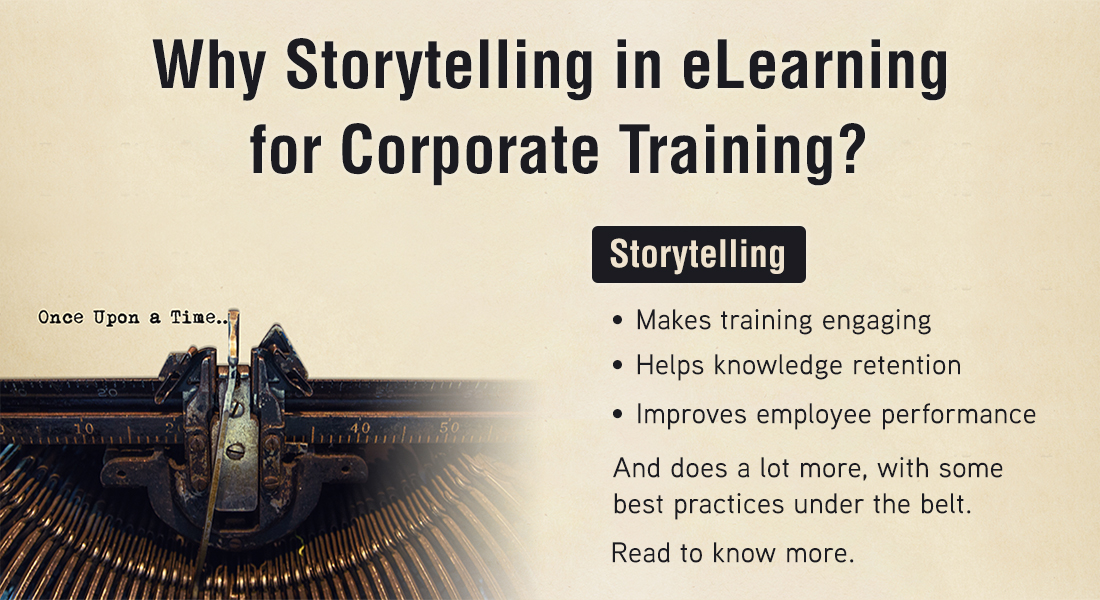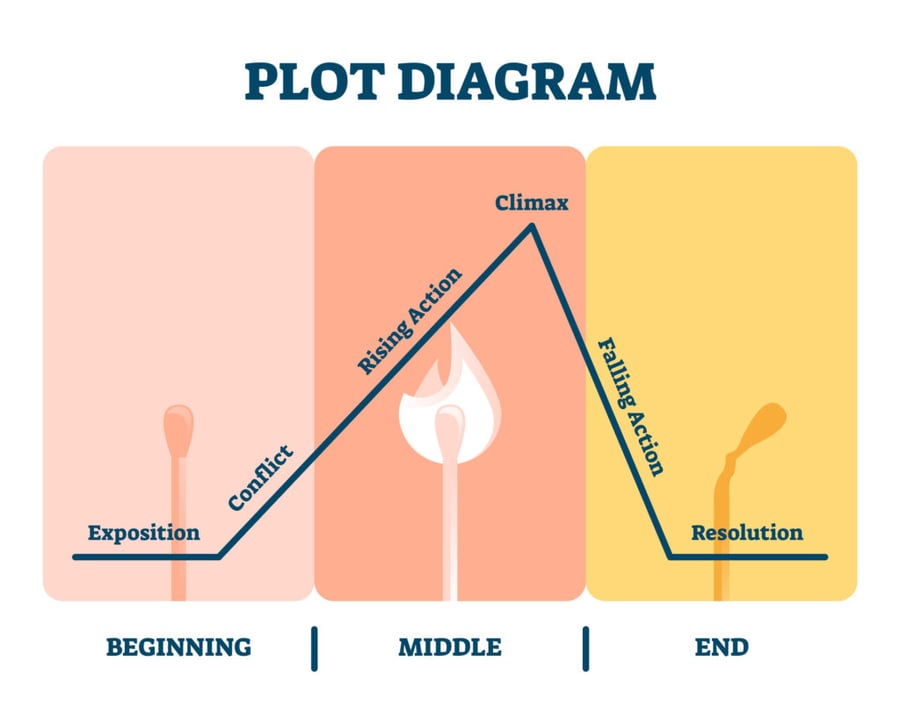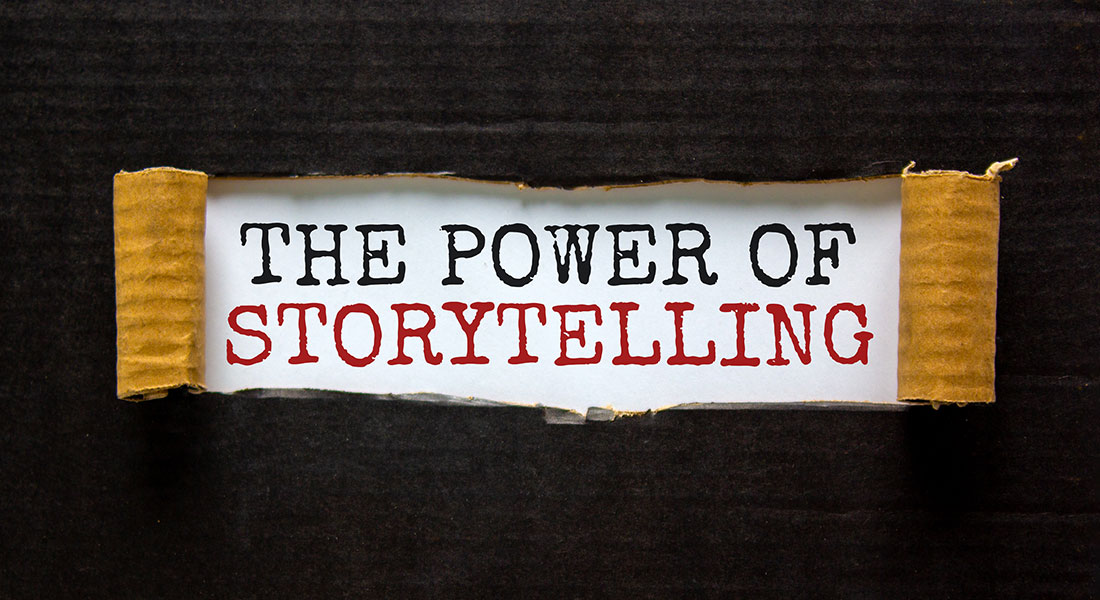Narratives to the Rescue: Storytelling in eLearning for Effective Training

Worried about your eLearning courses not having the desired outcomes? Have you considered the problem may be with the way the eLearning courses are designed and presented, and not with the content or the learners? Maybe the courses are boring, so they don’t stick in learners’ long-term memory?
Storytelling in eLearning – What to Keep in Mind.
Why should you use it?
- Makes training interesting
- Increases knowledge retention
- Improves employee performance
How should you use it?
- Keep the stories relevant
- Focus on the content and not the narrative
- Be sensitive to different cultures
- Follow the problem – solution approach
Incorporating storytelling in eLearning is an interesting way of increasing retention and improving overall training outcomes. Storytelling in eLearning does not mean fictional tales with an unreal ending. It is presenting the required content (based on the learning objectives) in the form of an engaging story that learners can connect with. This emotional element ensures that the content is retained in their long-term memory. Numerous studies have shown the strong link between storytelling and knowledge retention.
If you think your conventional eLearning needs a storytelling twist, you have come to the right place. This blog discusses the scientific rationale behind storytelling and why it is such an effective tool for facilitating retention.
Get Started with eLearning and Increase Employee Productivity and Competency.
Okay agreed, storytelling increases knowledge retention in the learner. But does that mean you can walk into a class and start the training on a new product with, “Once upon a time, a new smartphone named X1 decided he was done with micro USB charging ports…”? Storytelling for training does not work that way. What works however, is integrating the story within eLearning – something that learners will immediately find an emotional connect with. So without further ado, let’s dive into the world of storytelling in eLearning and see what mystical new knowledge awaits us.
The Science behind Storytelling for Better Engagement, Attention, and Retention
Back in 1944, two psychologists named Fritz Heider and Marianne Simmel, made a film using a couple of triangles, a circle, and a rectangle. (Read about the study here or if you want, check out the film here). While all that the film showed was the shapes moving and interacting with each other, all but one of the viewers who were shown the film connected the film with emotions and motivations. The movement and interaction of the shapes was enough to induce a sense of empathy within the viewers. It was as if the movements of the geometric shapes were trying to tell a story.
Neurologists have long concluded that sharing information in the form of stories leads to the information being better organized in the human brain. In fact, an experiment has shown that storytelling and narratives can be used to teach complex scientific facts and figures to people with little or no scientific background.
We know that stories have always engrossed us, but what is the reason for that? Anything out of the ordinary, interesting, and engaging makes our brains’ neurons fire more electrical pulses, which in turn helps us remember more than what we normally would. And that is why storytelling becomes almost like a cheat code for eLearning. Want to know how?
Storytelling for eLearning – What They Don’t Tell You
Let’s take a look at the role of storytelling in helping learners retain information, when used in eLearning for corporate training.
1. Uninteresting Training Hinders Learning and Development
Why is it that we remember a joke from ten years ago but forget what the Coriolis Effect is? It is because we did not learn about that concept in a sufficiently interesting and engaging manner? I learned about the Coriolis Effect from a conversation between two characters in my favourite video game, and still have not forgotten it.
Complexity of concepts is not the problem here. The content that is churned out for training is, for the most part, hardly interesting. Yes, elements like gamification and interactivities add some element of engagement. Integrating a story into gamification will make your learners immerse themselves in the learning. And that is what your eLearning course should be – inspiring and unconventional. You are not trying to bore your learners into hating the training, but rather make them appreciate what they are learning. Adding bits of stories and narratives gives the learners a different perspective – something they would appreciate in their training.
2. Storytelling Helps Learners Remember Most of Learned Content
One of the common challenges that trainers face is that of learners forgetting most of what they have learned within a single day. In fact, research suggests that people tend to forget almost 50% of whatever they have learned in just one hour. A sad outcome for corporate training indeed.
Implementing storytelling in eLearning can help combat this issue. As I have said before, engaging and relatable stories can improve the brain’s neural activity to a significant extent. Once a learner starts to engage with the content to understand it, chances of forgetting that information dramatically go down.
3. Learning through Stories Improves Employee Performance
Believe it or not, storytelling in eLearning for employee training can actually improve their overall performance. How is that?
Employee performance is highly dependent on the level of motivation and interest that s/he feels towards the work. An eLearning course with a hooking narrative increases their level of interest and engagement towards the course. This, combined with the increased brain activity, not only makes the learners remember what they learned, but also works as an impetus for them to perform well.
What’s the catch?
Storytelling seems like too good a strategy to use isn’t it? That’s because it probably is. Most TV shows or movies that we ‘binge-watch’ on have really amazing stories to tell. Unfortunately, we cannot replicate the same in eLearning. There are certain restrictions, like learning objectives and timelines, which we need to be mindful of. So, here is a list of best practices you need to follow while implementing storytelling in eLearning.
Best Practice 1 – Keep the Stories Relatable and Relevant for Your Learner
The last thing you want your eLearning course to do is to disengage your learners. And that might happen even when you include storytelling, if the story is not relevant to the learners and their context. For that you need to understand your learners and the problems they face while performing their jobs. Unlike my example of the Coriolis Effect (which I’m sure some of you Googled), you should keep your stories relevant, something he/she can relate to.
Best Practice 2 – The Story is Not the Focus, Content Is.
While implementing storytelling in eLearning, you have to remember that the objective is not to tell learners a story, but to teach them something using that story. Therefore, your stories and narratives should contain only relevant information and not too much of extraneous stuff.
Best Practice 3 – Be Sensitive to Cultural Differences
This is quite an important aspect to remember, especially with a global workforce. Storytelling works well, but only if it is used with sensitivity. Cultural factors can range from the description (or appearance) of a character, to culture specific sports and games mentioned in the story, if any. Would you tell a story about cricket to American learners? I thought not. Similarly, even when translating your courses, if they include a story, don’t just translate the language but also carry over the meaning in a culturally sensitive manner.
Best Practice 4 – End the Narrative with a Resolution to a Problem.
Though most 21st century stories hook the audience because of their unforeseen twists, the good old ‘problem – solution’ approach to storytelling works best when it comes to employee training. The story should guide your learners achieve a particular learning objective, enabling them to solve a particular problem.
So, introduce a character with whom the learner can relate to, add the other structural elements needed for a good story, and take it to the resolution where the learner can achieve the objective along with the protagonist.

Curtain Calls!
A story does not necessarily need the conventional elements of storytelling (like a hero and a villain), but should be something that the learners can relate to. And when training a large group of learners, the best way to relate to them all is by finding common ground with all their experiences. This of course means that the courses will not have a Dan Brown, Rowling, or Tolkien touch to them. But it also means that the learner will focus on the story and its outcomes, and not just the characters.
While storytelling in eLearning for corporate training is just one among a wide variety of strategies used, it still is a highly effective methodology that you can implement in your training. But there’s more to storytelling in eLearning than can be covered in a 12 min blog. The science is quite different from the art of telling a story. Keep an eye out as I just might drop a bestseller sometime soon.
If you think that storytelling is not suited for your type of training, this eBook has a wide range of microlearning tricks and tips that will surely help.





